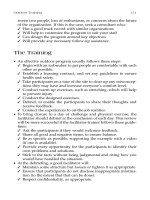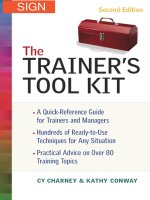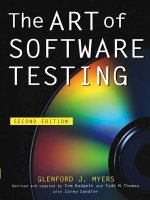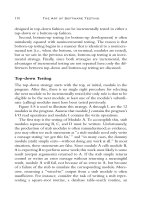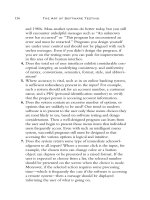The art of software testing second edition phần 1 pdf
Bạn đang xem bản rút gọn của tài liệu. Xem và tải ngay bản đầy đủ của tài liệu tại đây (269.44 KB, 26 trang )
The Art of
Software
Testing
Second Edition
Glenford J. Myers
Revised and Updated by
Tom Badgett and Todd M. Thomas
with Corey Sandler
John Wiley & Sons, Inc.
ffirs.qxd 4/29/04 4:39 PM Page iii
ffirs.qxd 4/29/04 4:39 PM Page ii
The Art of
Software
Testing
ffirs.qxd 4/29/04 4:39 PM Page i
ffirs.qxd 4/29/04 4:39 PM Page ii
The Art of
Software
Testing
Second Edition
Glenford J. Myers
Revised and Updated by
Tom Badgett and Todd M. Thomas
with Corey Sandler
John Wiley & Sons, Inc.
ffirs.qxd 4/29/04 4:39 PM Page iii
Copyright © 2004 by Word Association, Inc. All rights reserved.
Published by John Wiley & Sons, Inc., Hoboken, New Jersey.
Published simultaneously in Canada.
No part of this publication may be reproduced, stored in a retrieval system, or
transmitted in any form or by any means, electronic, mechanical, photocopying,
recording, scanning, or otherwise, except as permitted under Section 107 or 108 of
the 1976 United States Copyright Act, without either the prior written permission
of the Publisher, or authorization through payment of the appropriate per-copy fee to
the Copyright Clearance Center, Inc., 222 Rosewood Drive, Danvers, MA 01923,
(978) 750-8400, fax (978) 646-8600, or on the web at www.copyright.com. Requests
to the Publisher for permission should be addressed to the Permissions Department,
John Wiley & Sons, Inc., 111 River Street, Hoboken, NJ 07030, (201) 748-6011, fax
(201) 748-6008.
Limit of Liability/Disclaimer of Warranty: While the publisher and author have used
their best efforts in preparing this book, they make no representations or warranties
with respect to the accuracy or completeness of the contents of this book and
specifically disclaim any implied warranties of merchantability or fitness for a
particular purpose. No warranty may be created or extended by sales representatives
or written sales materials. The advice and strategies contained herein may not be
suitable for your situation. The publisher is not engaged in rendering professional
services, and you should consult a professional where appropriate. Neither the
publisher nor author shall be liable for any loss of profit or any other commercial
damages, including but not limited to special, incidental, consequential, or other
damages.
For general information on our other products and services please contact our
Customer Care Department within the United States at (800) 762-2974, outside the
United States at (317) 572-3993 or fax (317) 572-4002.
Wiley also publishes its books in a variety of electronic formats. Some content that
appears in print may not be available in electronic books. For more information about
Wiley products, visit our web site at www.Wiley.com.
Library of Congress Cataloging-in-Publication Data:
Myers, Glenford J.
The art of software testing / Glenford J. Myers ; Revised and updated by Tom
Badgett and Todd Thomas, with Corey Sandler.—2nd ed.
p. cm.
ISBN 0-471-46912-2
1. Computer software—Testing. 2. Debugging in computer science. I. Badgett, Tom.
II. Thomas, Todd M. III. Sandler, Corey, 1950– IV. Title.
QA76.6.M888 2004
005.1'4—dc22 2004002227
Printed in the United States of America
10987654321
ffirs.qxd 4/29/04 4:39 PM Page iv
Contents
List of Figures and Tables ix
Preface xi
Introduction xiii
Chapter 1 A Self-Assessment Test 1
Chapter 2 The Psychology and Economics
of Program Testing 5
The Psychology of Testing 5
The Economics of Testing 9
Black-Box Testing 9
White-Box Testing 11
Software Testing Principles 14
Summary 20
Chapter 3 Program Inspections, Walkthroughs,
and Reviews 21
Inspections and Walkthroughs 22
Code Inspections 24
An Error Checklist for Inspections 27
Data Reference Errors 27
Data-Declaration Errors 29
Computation Errors 30
Comparison Errors 31
Control-Flow Errors 32
Interface Errors 34
Input/Output Errors 35
Other Checks 38
v
ftoc.qxd 4/29/04 4:40 PM Page v
Walkthroughs 38
Desk Checking 40
Peer Ratings 40
Summary 42
Chapter 4 Test-Case Design 43
White-Box Testing 44
Logic-Coverage Testing 44
Equivalence Partitioning 52
An Example 56
Boundary-Value Analysis 59
Cause-Effect Graphing 65
Error Guessing 88
The Strategy 90
Chapter 5 Module (Unit) Testing 91
Test-Case Design 92
Incremental Testing 105
Top-down versus Bottom-up Testing 109
Top-down Testing 110
Bottom-up Testing 116
A Comparison 118
Performing the Test 120
Chapter 6 Higher-Order Testing 123
Function Testing 129
System Testing 130
Facility Testing 133
Volume Testing 133
Stress Testing 134
Usability Testing 135
Security Testing 137
Performance Testing 137
Storage Testing 138
Configuration Testing 138
vi Contents
ftoc.qxd 4/29/04 4:40 PM Page vi
Compatibility/Configuration/Conversion Testing 138
Installability Testing 139
Reliability Testing 139
Recovery Testing 141
Serviceability Testing 142
Documentation Testing 142
Procedure Testing 142
Performing the System Test 143
Acceptance Testing 144
Installation Testing 144
Test Planning and Control 145
Test Completion Criteria 148
The Independent Test Agency 155
Chapter 7 Debugging 157
Debugging by Brute Force 158
Debugging by Induction 160
Debugging by Deduction 164
Debugging by Backtracking 168
Debugging by Testing 169
Debugging Principles 170
Error-Locating Principles 170
Error-Repairing Techniques 171
Error Analysis 173
Chapter 8 Extreme Testing 177
Extreme Programming Basics 178
Extreme Testing: The Concepts 183
Extreme Unit Testing 183
Acceptance Testing 185
Extreme Testing Applied 186
Test-Case Design 186
Test Driver and Application 189
Summary 191
Contents vii
ftoc.qxd 4/29/04 4:40 PM Page vii
Chapter 9 Testing Internet Applications 193
Basic E-commerce Architecture 194
Testing Challenges 196
Testing Strategies 200
Presentation Layer Testing 202
Business Layer Testing 205
Data Layer Testing 208
Appendix A Sample Extreme Testing Application 213
Appendix B Prime Numbers Less Than 1,000 221
Glossary 223
Index 227
viii Contents
ftoc.qxd 4/29/04 4:40 PM Page viii
List of Figures and Tables
Figure 2.1 Control-Flow Graph of a Small Program 12
Table 2.1 Vital Program Testing Guidelines 15
Figure 2.2 The Surprising Errors Remaining/
Errors Found Relationship 20
Table 3.1 Inspection Error Checklist Summary, Part I 36
Table 3.2 Inspection Error Checklist Summary, Part II 37
Figure 4.1 A Small Program to Be Tested 47
Figure 4.2 Machine Code for the Program in Figure 4.1 50
Figure 4.3 A Form for Enumerating Equivalence Classes 54
Table 4.1 Equivalence Classes 57
Figure 4.4 Input to the MTEST Program 62
Figure 4.5 Basic Cause-Effect Graph Symbols 68
Figure 4.6 Sample Cause-Effect Graph 69
Figure 4.7 Logic Diagram Equivalent to Figure 4.6 69
Figure 4.8 Constraint Symbols 70
Figure 4.9 Symbol for “Masks” Constraint 71
Figure 4.10 Sample Cause-Effect Graph with “Exclusive”
Constraint 71
Figure 4.11 Syntax of the DISPLAY Command 72
Figure 4.12 Beginning of the Graph for the DISPLAY Command 76
Figure 4.13 Full Cause-Effect Graph without Constraints 77
Figure 4.14 Complete Cause-Effect Graph of the DISPLAY Command 78
Figure 4.15 Considerations Used When Tracing the Graph 80
Figure 4.16 Sample Graph to Illustrate the Tracing Considerations 81
Figure 4.17 First Half of the Resultant Decision Table 82
Figure 4.18 Second Half of the Resultant Decision Table 84
Figure 5.1 Input Tables to Module BONUS 93
Figure 5.2 Module BONUS 94
Table 5.1 Situations Corresponding to the Decision Outcomes 96
ix
fbetw.qxd 5/5/04 1:36 PM Page ix
Figure 5.3 Test Cases to Satisfy the Decision-Coverage Criterion 97
Table 5.2 Situations Corresponding to the Condition Outcomes 98
Figure 5.4 Test Cases to Satisfy the Condition-Coverage Criterion 99
Figure 5.5 Test Cases to Satisfy the Multicondition-Coverage Criterion 100
Figure 5.6 Supplemental Boundary-Value-Analysis Test Cases
for BONUS 104
Figure 5.7 Sample Six-Module Program 106
Figure 5.8 Sample 12-Module Program 111
Figure 5.9 Second Step in the Top-down Test 113
Figure 5.10 Intermediate State in the Top-down Test 115
Figure 5.11 Intermediate State in the Bottom-up Test 118
Table 5.3 Comparison of Top-down and Bottom-up Testing 119
Figure 6.1 The Software Development Process 124
Figure 6.2 The Development Process with Intermediate
Verification Steps 126
Figure 6.3 The Correspondence between Development and Testing
Processes 127
Figure 6.4 The System Test 131
Table 6.1 Hours per Year for Various Uptime Requirements 141
Table 6.2 Hypothetical Estimate of When the Errors
Might Be Found 151
Figure 6.5 Estimating Completion by Plotting Errors Detected
by Unit Time 153
Figure 6.6 Postmortem Study of the Testing Processes
of a Large Project 154
Figure 7.1 The Inductive Debugging Process 161
Figure 7.2 A Method for Structuring the Clues 162
Figure 7.3 An Example of Clue Structuring 163
Figure 7.4 The Deductive Debugging Process 165
Figure 7.5 Test Case Results from the DISPLAY Command 166
Table 8.1 The 12 Practices of Extreme Programming 180
Table 8.2 Test Case Descriptions for check4Prime.java 187
Table 8.3 Test Driver Methods 189
Figure 9.1 Typical Architecture of an E-Commerce Site 195
Table 9.1 Examples of Presentation, Business, and Data
Tier Testing 199
Figure 9.2 Detailed View of Internet Application Architecture 202
Table 9.2 Items to Test in Each Tier 203
x List of Figures and Tables
fbetw.qxd 5/5/04 1:36 PM Page x
Preface
In 1979, Glenford Myers published
a book that turned out to be a classic. Myers’s original The Art of Soft-
ware Testing stood the test of time, 25 years on the publisher’s list of
available books. This fact alone is a testament to the solid, basic, and
valuable nature of his work.
During that same time, the current authors of the updated version
of this book published collectively more than 120 books, most of
them on computer software topics. Some of these books sold very
well, going through multiple versions. (Corey Sandler’s Fix Your Own
PC is in its seventh edition as this book is written, and Tom Badgett’s
books on Microsoft PowerPoint and other Office titles went through
four or more editions, for example.) Nevertheless, none of the current
authors’ books remained current more than a few years.
What is the difference? These newer books cover more transient
topics: operating systems, applications software, security, communi-
cations technology, and hardware configurations. Rapid changes in
computer hardware and software technology during the 1980s and
1990s necessitated frequent changes and updates to these topics.
During that period dozens—perhaps even hundreds—of books
also were published about software testing. They, too, took a more
transient approach to the topic.
Myers’s The Art of Software Testing, on the other hand, gave the
industry a long-lasting, foundational guide to one of the most impor-
tant computer topics: How do you ensure that all of the software you
produce does what it was designed to do and, just as important, does
not do what it isn’t supposed to do?
xi
fpref.qxd 4/29/04 4:40 PM Page xi
The version you are reading today retains that same foundational
philosophy. We have updated the examples to include more current
programming languages, and we have addressed topics that no one
knew about when Myers wrote the first edition: Web programming,
e-commerce, and Extreme Programming and Testing.
But we didn’t forget that a new classic must be true to its roots, so
this version also offers you a software testing philosophy that is all
Glenford Myers, a philosophy and a process that work across current
and unforeseeable future hardware and software platforms. Hopefully
this, too, is a book that will span a generation of software designers
and developers.
xii Preface
fpref.qxd 4/29/04 4:40 PM Page xii
Introduction
At the time this book was first
published, in 1979, it was a well-known rule of thumb that in a typ-
ical programming project approximately 50 percent of the elapsed
time and more than 50 percent of the total cost were expended in
testing the program or system being developed.
Today, a quarter of the century later, the same is still true. There
are new development systems, languages with built-in tools, and pro-
grammers who are used to developing more on the fly. But testing
still plays an important part in any software development project.
Given these facts, you might expect that by this time program test-
ing would have been refined into an exact science. This is far from
true. In fact, less seems to be known about software testing than
about any other aspect of software development. Furthermore, test-
ing has been an out-of-vogue subject—it was true when this book
was first published and, unfortunately, it is still true today. Today there
are more books and articles about software testing, meaning that, at
least, the topic has more visibility than it did when this book was first
published. But testing remains among the “dark arts” of software
development.
This would be more than enough reason to update this book on
the art of software testing, but there are additional motivations. At
various times, we have heard professors and teaching assistants say,
“Our students graduate and move into industry without any substan-
tial knowledge of how to go about testing a program. Moreover, we
rarely have any advice to provide in our introductory courses on how
a student should go about testing and debugging his or her exercises.”
xiii
flast.qxd 4/29/04 4:39 PM Page xiii
So, the purpose of this updated edition of The Art of Software Test-
ing is the same as it was in 1979: to fill these knowledge gaps for the
professional programmer and the student of computer science. As the
title implies, the book is a practical, rather than theoretical, discussion
of the subject, complete with updated language and process discus-
sions. Although it is possible to discuss program testing in a theoreti-
cal vein, this book is intended to be a practical, “both feet on the
ground” handbook. Hence, many subjects related to program testing,
such as the idea of mathematically proving the correctness of a pro-
gram, were purposefully excluded.
Chapter 1 is a short self-assessment test that every reader should
take before reading further. It turns out that the most important prac-
tical information that you must understand about program testing is
a set of philosophical and economic issues; these are discussed in
Chapter 2. Chapter 3 discusses the important concept of non-
computer-based code walk-throughs or inspections. Rather than
focus attention on the procedural or managerial aspects of this con-
cept, as most discussions do, Chapter 3 discusses it from a technical,
how-to-find-errors point of view.
The knowledgeable reader will realize that the most important
component in the bag of tricks of a program tester is the knowledge
of how to write effective test cases; this is the subject of Chapter 4.
Chapters 5 and 6 discuss, respectively, the testing of individual mod-
ules or subroutines and the testing of larger entities, with Chapter 7
presenting some practical advice on program debugging. Chapter 8
discusses the concepts of extreme programming and extreme testing,
while Chapter 9 shows how to use other features of program testing
detailed elsewhere in this book with Web programming, including
e-commerce systems.
This book has three major audiences. Although we hope that not
everything in this book will be new information to the professional
programmer, it should add to the professional’s knowledge of testing
techniques. If the material allows you to detect just one more bug in
one program, the price of the book will have been recovered many
times over. The second audience is the project manager, since the
book contains new, practical information on the management of the
xiv Introduction
flast.qxd 4/29/04 4:39 PM Page xiv
testing process. The third audience is the programming or computer
science student; the goal here is to expose the student to the problems
of program testing and to provide a set of effective techniques. It is
suggested that the book be used as a supplement in programming
courses such that the student is exposed to the subject of software
testing at an early time in his or her education.
Glenford J. Myers
Tom Badgett
Todd M. Thomas
Corey Sandler
Introduction xv
flast.qxd 4/29/04 4:39 PM Page xv
flast.qxd 4/29/04 4:39 PM Page xvi
The Art of
Software
Testing
flast.qxd 4/29/04 4:39 PM Page xvii
flast.qxd 4/29/04 4:39 PM Page xviii
CHAPTER 1
A Self-Assessment Test
Since this book was first published
25 years ago, software testing has become both easier and more diffi-
cult than ever.
Software testing is more difficult because of the vast array of pro-
gramming languages, operating systems, and hardware platforms that
have evolved. And, while relatively few people used computers in the
1970s, today virtually anyone in business or education could hardly
complete a day’s work without using a computer. Furthermore, the
machines themselves are hundreds of times more powerful than those
early devices.
Therefore, the software we write today potentially touches mil-
lions of people, enabling them to do their jobs effectively and effi-
ciently—or causing them untold frustration and the cost of lost work
or lost business. This is not to say that software is more important
today than it was when the first edition of this book was published,
but it is safe to say that computers—and the software that drives
them—certainly affect more people and more businesses today.
Software testing is easier, in some ways, because the array of soft-
ware and operating systems is much more sophisticated than ever,
providing intrinsic well-tested routines that can be incorporated into
applications without the need for a programmer to develop them
from scratch. Graphical user interfaces (GUIs), for example, can be
built from a development language’s libraries, and, since they are pre-
programmed objects that have been debugged and tested previously,
the need for testing them as part of a custom application is much
reduced.
Software testing is a process, or a series of processes, designed to
make sure computer code does what it was designed to do and that it
1
01.qxd 4/29/04 4:32 PM Page 1
does not do anything unintended. Software should be predictable and
consistent, offering no surprises to users. In this book we will look at
many approaches to achieving this goal.
Now, before we start the book, we’d like you to take a short exam.
We want you to write a set of test cases—specific sets of data—to
properly test a relatively simple program. Create a set of test data for
the program—data the program must handle correctly to be consid-
ered a successful program. Here’s a description of the program:
The program reads three integer values from an input dialog. The
three values represent the lengths of the sides of a triangle. The
program displays a message that states whether the triangle is scalene,
isosceles, or equilateral.
Remember that a scalene triangle is one where no two sides are
equal, whereas an isosceles triangle has two equal sides, and an equi-
lateral triangle has three sides of equal length. Moreover, the angles
opposite the equal sides in an isosceles triangle also are equal (it also
follows that the sides opposite equal angles in a triangle are equal),
and all angles in an equilateral triangle are equal.
Evaluate your set of test cases by using it to answer the following
questions. Give yourself one point for each “yes” answer.
1. Do you have a test case that represents a valid scalene trian-
gle? (Note that test cases such as 1,2,3 and 2,5,10 do not
warrant a “yes” answer because there does not exist a triangle
having these dimensions.)
2. Do you have a test case that represents a valid equilateral tri-
angle?
3. Do you have a test case that represents a valid isosceles trian-
gle? (Note that a test case representing 2,2,4 would not count
because it is not a valid triangle.)
4. Do you have at least three test cases that represent valid
isosceles triangles such that you have tried all three permuta-
tions of two equal sides (such as, 3,3,4; 3,4,3; and 4,3,3)?
5. Do you have a test case in which one side has a zero value?
2 The Art of Software Testing
01.qxd 4/29/04 4:32 PM Page 2
6. Do you have a test case in which one side has a negative
value?
7. Do you have a test case with three integers greater than zero
such that the sum of two of the numbers is equal to the
third? (That is, if the program said that 1,2,3 represents a sca-
lene triangle, it would contain a bug.)
8. Do you have at least three test cases in category 7 such that
you have tried all three permutations where the length of
one side is equal to the sum of the lengths of the other two
sides (for example, 1,2,3; 1,3,2; and 3,1,2)?
9. Do you have a test case with three integers greater than zero
such that the sum of two of the numbers is less than the third
(such as 1,2,4 or 12,15,30)?
10. Do you have at least three test cases in category 9 such that
you have tried all three permutations (for example, 1,2,4;
1,4,2; and 4,1,2)?
11. Do you have a test case in which all sides are zero (0,0,0)?
12. Do you have at least one test case specifying noninteger val-
ues (such as 2.5,3.5,5.5)?
13. Do you have at least one test case specifying the wrong num-
ber of values (two rather than three integers, for example)?
14. For each test case did you specify the expected output from
the program in addition to the input values?
Of course, a set of test cases that satisfies these conditions does not
guarantee that all possible errors would be found, but since questions
1 through 13 represent errors that actually have occurred in different
versions of this program, an adequate test of this program should
expose at least these errors.
Now, before you become concerned about your own score, con-
sider this: In our experience, highly qualified professional program-
mers score, on the average, only 7.8 out of a possible 14. If you’ve
done better, congratulations; if not, we’ll try to help.
The point of the exercise is to illustrate that the testing of even a
trivial program such as this is not an easy task. And if this is true, con-
sider the difficulty of testing a 100,000-statement air traffic control
A Self-Assessment Test 3
01.qxd 4/29/04 4:32 PM Page 3
system, a compiler, or even a mundane payroll program. Testing also
becomes more difficult with the object-oriented languages such as
Java and C++. For example, your test cases for applications built with
these languages must expose errors associated with object instantia-
tion and memory management.
It might seem, from working with this example, that thoroughly
testing a complex, real-world program would be impossible. Not so!
Although the task can be daunting, adequate program testing is a
very necessary—and achievable—part of software development, as
you will learn in this book.
4 The Art of Software Testing
01.qxd 4/29/04 4:32 PM Page 4


